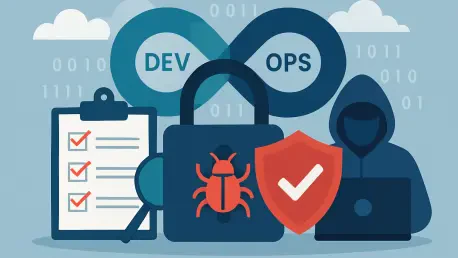In the fast-paced world of software development, the constant push for speed often clashes with the critical need for strong security, creating a tough environment for organizations aiming to innovate while safeguarding their systems. DevOps, a methodology that combines development and operations to streamline delivery, has become a key approach for building and deploying applications, especially in cloud environments. However, this focus on speed often pushes security to the back burner, leaving systems open to serious risks. The consequences of these oversights can be devastating, from data breaches to operational disruptions that damage trust and profitability. This article examines the vital connection between security and DevOps, highlighting risk assessment as a game-changing strategy for developing robust cloud applications that can resist evolving threats.
The tension between rapid deployment and protecting systems is a central challenge in today’s tech landscape. Companies face relentless pressure to roll out new features and updates to stay competitive, often prioritizing speed over thorough security measures. This approach is like building a house without locking the doors—functional for now, but vulnerable to break-ins. Security cannot be just an afterthought tacked on at the end of the development cycle; it must be embedded into the process from the very start. In a DevOps environment, where frequent updates and quick deployments are standard, ignoring this principle invites risks that can harm both reputation and financial stability.
Understanding the DevOps-Security Gap
The Speed-Security Dilemma
The core conflict between the need to deliver software quickly and the duty to ensure its security poses a major challenge for modern development teams. Organizations are driven to release updates at a rapid pace to meet market demands and user expectations, often sacrificing comprehensive security measures in the process. This rush can lead to systems that work but are inherently insecure, making them easy targets for exploits. Think of it as a race car built without brakes—high speed comes with high risk if safety isn’t a priority. Tackling this imbalance demands a fundamental change in mindset, recognizing that security must be as essential to the development process as the code itself, particularly in environments where rapid iterations are the norm.
This speed-security conflict is especially evident in DevOps, where the focus on continuous delivery increases the chance of mistakes. The pressure to keep a competitive pace often means security checks are delayed or scaled back, creating gaps for vulnerabilities to go unnoticed. These gaps can have serious consequences, such as unauthorized access to sensitive data or system downtime that halts business operations. Embedding security from the earliest stages of development isn’t just a precaution—it’s a must to avoid costly breaches. By acknowledging this tension, teams can start exploring strategies that balance the need for speed with the equally important need for strong protection.
Security Oversights in DevOps Practices
While DevOps has transformed software delivery through improved collaboration and efficiency, its framework often lacks a built-in focus on security, leaving dangerous gaps that can be exploited. The methodology’s key principles of continuous integration and continuous deployment (CI/CD) enable fast updates and feedback loops, but without clear security protocols, these processes can unintentionally introduce risks. Common problems, like misconfigured cloud storage or unprotected debug ports, often arise in the rush to deploy, acting as entry points for attackers. This oversight reveals a critical weakness in how DevOps is currently applied, where the push for speed can overshadow the need for caution.
Addressing these security lapses requires a deeper integration of protective measures into the DevOps pipeline, rather than treating them as an external or secondary task. Many organizations assume security can be handled after development, a misconception that often leads to disaster in dynamic cloud environments. Real-world cases show how quickly small errors can turn into major breaches if not caught early, underscoring the urgency of embedding safeguards throughout the development lifecycle. By recognizing these inherent weaknesses in DevOps practices, teams can begin to build frameworks that prioritize security as a core component, ensuring rapid delivery doesn’t compromise system integrity.
Strategies for Embedding Security in DevOps
Shifting Left for Early Intervention
The idea of “shifting left” is a key strategy for integrating security into the DevOps workflow by tackling potential risks at the earliest possible stage of development. Instead of waiting until the final stages or after deployment to perform security evaluations, this approach calls for starting these assessments during the initial design and planning phases. By identifying and analyzing threats from the start, development teams can prevent small issues from growing into major vulnerabilities that are costlier to fix later. This proactive method not only strengthens the overall security of applications but also fits the fast-paced nature of DevOps by cutting down on delays from last-minute fixes.
Implementing a shift-left strategy involves more than just early testing; it requires a cultural shift within teams to prioritize security alongside functionality from the beginning. This means using risk assessment tools and practices during the ideation and coding phases, ensuring potential weaknesses are caught before they become embedded in the system. Such an approach can significantly reduce the financial and operational burden of addressing security flaws after deployment, as early issues are often easier to fix. In cloud-based applications, where threats can come from many directions, this early intervention is even more crucial, providing a strong foundation for resilience against sophisticated attacks.
Continuous Risk Assessment as a Process
Risk assessment in a DevOps context must be seen as a dynamic, ongoing process rather than a one-time task limited to a specific phase of development. It involves constant communication among developers, operations staff, and other stakeholders to identify what could go wrong, understand the implications, and gauge the potential impact on the organization. In the complex world of cloud computing, where dependencies and configurations create a tangled web of potential failure points, this ongoing evaluation helps uncover risks that might otherwise stay hidden. Prioritizing actions based on the business impact of a threat, rather than just its likelihood, ensures resources are focused on the most critical areas.
This continuous approach to risk assessment builds a deeper understanding of the changing threat landscape, allowing teams to adapt their strategies as new challenges emerge. Unlike traditional models that might depend on periodic audits, integrating risk evaluation into every stage of the DevOps pipeline ensures security remains a constant focus, even as systems grow or evolve. Cloud environments, with their rapid changes and distributed setups, require this level of attention to prevent vulnerabilities from slipping through during updates or expansions. By treating risk as an ongoing conversation, organizations can create applications that are not only innovative but also fortified against the unpredictable nature of digital threats.
Navigating Cloud Complexity with Risk Assessment
Unique Challenges of Cloud Environments
Cloud computing offers unmatched scalability and flexibility, but it also brings unique complexities that can hide security risks and challenge even the most prepared teams. Modern tools like containers, orchestration platforms, and serverless architectures, while cutting-edge, often create layers of abstraction that make it hard to spot vulnerabilities. These environments can conceal issues such as improper access controls or misconfigured resources, which might go unnoticed without systematic evaluation. Risk assessment plays a crucial role in mapping out these intricate systems, pinpointing potential failure points, and clarifying where threats are most likely to appear, ensuring teams aren’t caught off guard by hidden dangers.
Beyond visibility, quantifying the potential impact of risks in cloud setups is vital for effective prioritization and resource allocation. This involves evaluating the consequences of failures—whether it’s data loss, service interruptions, or regulatory fines—and weighing them against the likelihood of occurrence. Such analysis helps decision-makers focus on the most urgent issues, rather than spreading efforts thinly across less critical concerns. Given the interconnected nature of cloud applications, where a single flaw can ripple across services, this structured approach to risk assessment becomes a foundation for maintaining security. It turns abstract threats into concrete metrics that guide actionable responses.
Security by Design in Practice
Adopting a “security by design” mindset means embedding risk-aware thinking into the daily practices of DevOps teams, moving beyond buzzwords to practical, actionable strategies. This approach isn’t about chasing the latest security trends for show but about fundamentally changing how systems are built from the ground up. It involves asking key questions at every stage—how is data handled, who has access, and what happens if a component fails? By weaving these considerations into the development process, teams can ensure security isn’t an afterthought but a core principle that shapes every decision, especially in the fast-moving world of cloud applications.
Reimagining the CI/CD pipeline as a dual-purpose tool for both delivery and risk management is a central part of security by design. Instead of seeing it only as a means for rapid deployment, it can be used to continuously monitor for vulnerabilities and flag potential issues as code evolves. This integration allows for immediate feedback on security risks during development cycles, enabling teams to tackle concerns without derailing timelines. In cloud environments, where configurations can change quickly, this ongoing scrutiny ensures security keeps up with innovation. By making risk awareness a practical part of daily workflows, organizations can build systems that are both efficient and inherently resistant to threats.
Building Resilience Through Preparedness
Metrics and Visibility for Informed Decisions
Effective risk assessment within DevOps depends heavily on turning raw data into meaningful insights through targeted metrics and improved visibility. Simply running numerous security scans or gathering huge amounts of data isn’t enough; the focus must be on actionable results that show which system parts are most vulnerable and what the potential fallout of a breach could be. Dashboards and reporting tools that highlight exposure levels and quantify impacts—such as financial losses or damage to customer trust—offer a clearer view of where risks lie. This strategic approach allows teams to move beyond reactive fixes and make informed decisions about where to focus their defensive efforts.
Visibility into risk also improves communication and collaboration across departments, ensuring everyone from developers to executives understands the security landscape. When metrics are designed to reflect real-world consequences rather than just abstract numbers, they become powerful tools for aligning priorities and justifying resource allocation. In cloud systems, where threats can emerge from unexpected areas, this clarity is essential for staying ahead of potential issues. By focusing on insights that drive action, rather than overwhelming teams with irrelevant data, organizations can build a security posture that is both proactive and precise, protecting critical assets in a constantly changing environment.
Resilience as Preparedness Over Perfection
Resilience in cloud applications should not be confused with an impossible goal of perfection but rather as a state of readiness to manage inevitable failures with minimal disruption. No system can be completely immune to threats, especially in the complex and ever-changing world of cloud computing, where new vulnerabilities appear regularly. Integrating risk assessment into DevOps prepares teams to anticipate weak spots, limit damage when incidents happen, and recover quickly. This preparedness—knowing where systems are most fragile and having plans to reduce impact—sets resilient applications apart from those that collapse under pressure, ultimately maintaining operational continuity and user confidence.
Looking back, the path to resilience involved realizing that failures were not rare events but expected challenges that required strategic planning. Risk assessment became a cornerstone in this process, providing a framework to identify and prioritize vulnerabilities long before they could be exploited. By embedding this practice into every layer of the DevOps pipeline, teams balanced the demands of speed with the needs of security, creating systems that could adapt to threats without sacrificing innovation. The way forward lies in continuing to refine these assessments, using advanced tools for deeper insights, and fostering a culture where preparedness remains a priority. This focus on readiness ensures that cloud applications not only survive but thrive amid the uncertainties of the digital landscape.









